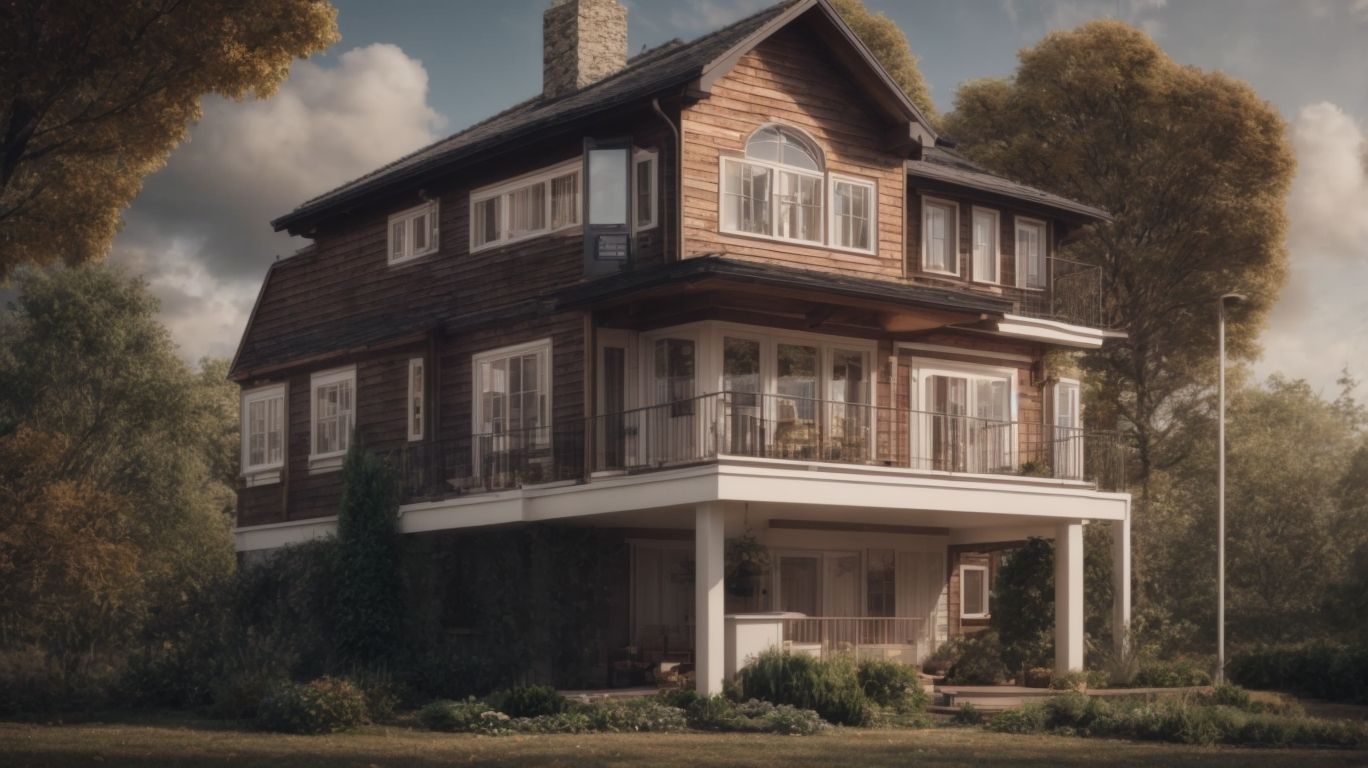
Timeline to the Top: How Long to Plan for Your Second Story Addition
Are you considering adding a second story to your home?
This comprehensive guide will walk you through the process, benefits, and timeline of a second story addition.
From increasing living space and property value to customization and avoiding moving costs, there are numerous advantages to expanding your home vertically.
Factors like size, materials, labor availability, and unexpected delays can affect the timeline.
Learn how to plan effectively for a successful second story addition project.
What Is a Second Story Addition?
A Second Story Addition involves the process of expanding a home vertically by adding a new level above the existing structure.
- This type of renovation project requires careful planning and execution to ensure that the new level seamlessly integrates with the existing home.
- Typically, the construction process involves reinforcing the foundation of the house to support the added weight of the second story. Quality building materials such as steel beams, lumber, and framing components are used to create the structural framework for the additional level.
- An architect plays a crucial role in designing the layout and ensuring that the Second Story Addition complies with building codes and zoning regulations to maintain the structural integrity and safety of the home.
What Are the Benefits of a Second Story Addition?
Opting for a Second Story Addition offers homeowners the advantages of increasing living space, boosting property value, and customizing their home to meet specific needs and preferences.
By adding a second level to your home, you not only create more room for your family to spread out and enjoy, but you also elevate the overall value of your property.
The additional space allows for greater flexibility in designing the layout of your house, giving you the opportunity to tailor it to your lifestyle. Whether you need extra bedrooms, a home office, or a designated play area for your kids, a second story addition offers endless possibilities for enhancing your living environment.
This level of customization ensures that your home perfectly aligns with your vision, maximizing homeowner satisfaction and potentially yielding a significant return on investment.
Increase Living Space
Expanding the living space through a Second Story Addition allows for the creation of additional rooms such as bedrooms, bathrooms, and kitchens, providing more functional and comfortable areas for residents.
With the addition of bedrooms, homeowners gain the flexibility to accommodate more family members or guests, offering privacy and personal space. Extra bathrooms ensure convenience and reduce congestion during busy mornings or evenings. Kitchens can be upgraded to include modern appliances and more counter space, enhancing cooking experiences. Spacious living rooms or home offices can be incorporated, catering to various needs and making the house feel more complete and versatile.
Increase Property Value
One of the significant benefits of a Second Story Addition is the potential to increase the property’s overall value, offering a favorable return on investment and positively impacting the property’s standing in the real estate market.
This enhancement not only improves the aesthetics and functionality of the home but also aligns with the current trend in the real estate market where buyers are increasingly looking for properties with added space and modern amenities. By adding a second story, you essentially unlock the opportunity to command a higher asking price should you decide to sell your property in the future. The increased square footage and improved layout can make your home more appealing to potential buyers, thereby speeding up the selling process and maximizing your ROI.
Avoid Moving Costs
By opting for a Second Story Addition, homeowners can avoid the expenses and hassles associated with moving to a new location, allowing them to stay in their current home and enjoy the benefits of additional space and customization.
This type of home renovation enables individuals to expand their living area without the need to uproot and relocate. With a second story addition, homeowners get to maintain their familiar neighborhood, established routines, and connections. The process not only saves them from the financial burdens of moving costs but also spares them from the disruptions and uncertainties that come with changing residences. It’s a practical solution that enhances the property’s value while ensuring a seamless transition to a more spacious and personalized living environment.
Customize Your Home
Customizing your home through a Second Story Addition enables you to tailor the design, layout, and features to align with your preferences, allowing for interior and exterior modifications, upgrades, and personalized touches.
This flexibility extends to the interior spaces, giving you the freedom to choose materials, colors, and fittings that resonate with your style. From selecting flooring options to deciding on the placement of windows, every detail can reflect your unique vision.
The exterior facade can be transformed to match your desired aesthetic, whether it’s adding a balcony to enhance curb appeal or incorporating architectural elements that showcase your personality. With the ability to personalize every aspect of your home, a Second Story Addition offers endless opportunities for creating a space that truly feels like your own.
How Long Does a Second Story Addition Take?
The duration of a Second Story Addition project typically varies based on the planning process, construction timeline, and the complexity of the renovation, with completion marking the final stage of the project.
- During the planning phase, key considerations include obtaining necessary permits, finalizing architectural designs, and confirming project budget and timeline.
- Once the planning is complete, the construction phase begins, involving processes such as structural modifications, framing, roofing, electrical and plumbing installations, insulation, and finishing work.
- Efficient project management plays a crucial role in coordinating various tasks to ensure timely completion. The journey towards project completion involves regular site inspections, quality checks, and addressing any unexpected challenges that may arise during the construction process.
Planning and Design Phase
The initial stage of a Second Story Addition project involves meticulous planning, design conceptualization, and blueprint creation to define the project scope, architectural requirements, and layout specifics.
During the planning and design phase, careful consideration must be given to the layout and functionality of the existing structure to ensure a seamless integration with the new addition. Architects work closely with clients to understand their needs and preferences, incorporating them into the design process.
Detailed blueprints are drafted, focusing on structural integrity, zoning regulations, and aesthetic appeal. Attention is also paid to natural light, ventilation, and energy efficiency to create a harmonious living space. The architectural aspects are crucial in laying the foundation for a successful Second Story Addition project.
Obtaining Permits
Securing the necessary building permits from local authorities is a crucial step in the Second Story Addition process, ensuring compliance with zoning regulations, building codes, and legal requirements.
It is essential to understand that obtaining building permits not only guarantees compliance with regulations but also ensures the safety and structural integrity of the new construction. Navigating the permitting process can be intricate, involving thorough documentation, site inspections, and approval timelines. By liaising effectively with local authorities, homeowners can streamline the approval process, address any zoning concerns, and avoid potential legal issues. Adhering to building codes and zoning regulations is imperative for maintaining the structural stability of the property and fostering a safe environment for occupants.
Demolition and Prep Work
Preparing the site for a Second Story Addition involves demolition of existing structures, foundation work, and insulation installation to create a solid base for the construction of the new level.
The process of site preparation typically begins with a thorough assessment of the existing structures to determine which portions need to be demolished for the expansion. Once the demolition is completed, attention shifts to laying the foundation for the new story, which is crucial for the structural integrity of the future addition.
Proper insulation plays a key role not only in maintaining comfortable temperatures but also in energy efficiency, making it an essential component in the early stages of laying the groundwork for the second story. Insulation requirements vary depending on the climate and local building codes, so it’s important to ensure compliance with these regulations during this phase of construction.
Construction of Second Story
The construction phase of a Second Story Addition involves framing, roof installation, plumbing, electrical work, and the integration of new structural elements to bring the new level to fruition.
- Framing is a crucial first step, typically done with wooden studs to create the skeleton of the new floor.
- The roof installation follows, with trusses or rafters being put in place to provide structural support and protection.
- Plumbing and electrical work then take center stage, as new pipes and wiring need to be carefully integrated into the existing systems. Attention to detail is key during this phase to ensure proper functionality and safety.
- The installation of structural components, such as beams and columns, adds strength and stability to the newly expanded space.
Finishing Touches
The final stage of a Second Story Addition involves inspection processes, finishing touches, fixture installation, and the completion of interior and exterior finishes to bring the project to a polished and functional state.
This phase is crucial as it signifies the transition from construction to a livable space. During the inspection stage, professionals meticulously review all aspects of the addition to ensure compliance with building codes and safety standards. Once inspections are passed, the focus shifts to finish installations, where attention to detail is paramount.
From paint colors and flooring choices to lighting fixtures and cabinetry placements, every decision contributes to the overall aesthetic. Proper fixture placements add functionality and style, elevating the space. The implementation of these finishing touches is what truly transforms the addition into a harmonious extension of the existing home.
What Factors Can Affect the Timeline of a Second Story Addition?
Several factors can influence the timeline of a Second Story Addition project, including the size and complexity of the addition, material and labor availability, weather conditions, and unexpected issues or delays that may arise during construction.
- The size and complexity of the addition play a crucial role in determining the duration of the project, as larger and more intricate designs often require additional time for planning and execution.
- The availability of materials and skilled labor can significantly impact the timeline, as delays in sourcing essential resources can result in project setbacks.
- Unpredictable weather conditions, such as rain or extreme temperatures, can also disrupt construction schedules, necessitating flexible strategies to adapt to such challenges.
To counter these variables, proactive management techniques are essential to identify potential risks, implement contingency plans, and maintain efficient progress throughout the project timeline.
Size and Complexity of the Addition
The scale and intricacy of a Second Story Addition play a significant role in determining the timeline, with larger additions or structural modifications requiring more time for completion due to the detailed planning and construction involved.
When considering the size and complexity of the addition, it’s crucial to factor in the structural integrity requirements of the existing building. This may involve reinforcing the foundation or implementing support beams to ensure that the new second story is structurally sound.
The space considerations come into play when determining the layout of bedrooms, bathrooms, and other functional areas. Optimizing the use of space is key to creating a comfortable and functional living environment within the confines of the existing structure.
Availability of Materials and Labor
Timely completion of a Second Story Addition is heavily influenced by the availability of construction materials, skilled contractors, and efficient scheduling to ensure smooth progress throughout the project.
Ensuring that the necessary materials such as framing lumber, roofing materials, and electrical components are readily available when needed plays a critical role in preventing costly delays.
Effective coordination with subcontractors and suppliers, coupled with a well-structured procurement strategy, helps in maintaining a steady workflow.
Skilled contractors proficient in their trade bring expertise to the project, allowing for seamless execution of tasks according to the schedule.
Prioritizing scheduling efficiency and adopting proactive project management practices are essential in meeting project timelines and delivering high-quality results within budget constraints.
Weather Conditions
Unpredictable weather conditions can impact the construction timeline of a Second Story Addition, especially during roofing, insulation, HVAC installations, and exterior modifications that are sensitive to climatic variations.
When extreme weather hits, such as heavy rainfall, strong winds, or extreme temperatures, it can lead to delays in roofing projects, affect the curing process of insulation materials, and hinder the installation of HVAC systems.
To combat these challenges, construction teams can proactively weather-proof their worksites by using durable materials resistant to weather fluctuations, employing flexible scheduling techniques to adjust to sudden weather changes, and setting up protective measures like temporary enclosures to shield ongoing works from adverse conditions. Adopting such strategies can help maintain project continuity and minimize weather-related disruptions in construction projects.
Unexpected Issues or Delays
Unforeseen challenges or delays in inspections, completion processes, or ongoing maintenance requirements can disrupt the timeline of a Second Story Addition, necessitating effective problem-solving and proactive management strategies.
Such unexpected issues can significantly impact the overall progress of the project, leading to potential cost overruns and client dissatisfaction. To mitigate these risks, it is crucial for project managers to implement rigorous inspection protocols, efficient completion procedures, and strategic maintenance planning. By prioritizing proactive measures, teams can better anticipate and address unforeseen obstacles, ensuring smooth project continuity and minimizing the impact of any unexpected delays on the overall timeline of the construction project.
How Can You Plan for a Successful Second Story Addition?
Planning for a successful Second Story Addition involves setting a realistic budget, engaging in effective project management practices, and hiring reputable contractors to ensure a smooth and efficient renovation process.
To effectively allocate your budget for a second-story addition, it is essential to thoroughly scope out the project before construction begins. Start by consulting with an experienced architect who can help you visualize the design and layout of the new space. Clear communication and detailed planning are crucial in project management to keep timelines on track and avoid unexpected expenses. When hiring contractors, prioritize experience, expertise, and a proven track record in similar projects to ensure high-quality workmanship and adherence to building codes.
Set a Realistic Timeline
Establishing a realistic timeline for a Second Story Addition involves evaluating the scope of work, estimating duration, and creating a detailed schedule to track progress and ensure timely project completion.
When setting a timeline for a Second Story Addition, it’s crucial to consider various scheduling factors such as permits, weather conditions, material availability, and subcontractor availability. These elements can significantly impact the overall project timeline.
Duration estimates should account for potential delays and buffer time to accommodate unforeseen circumstances. Tracking milestones throughout the project is essential to monitor progress, identify any deviations from the schedule, and make necessary adjustments to maintain efficiency and meet deadlines.
Effective progress tracking helps ensure that the project stays on track and meets client expectations.
Work with a Reputable Contractor
Collaborating with a reputable contractor for a Second Story Addition ensures quality construction, adherence to building codes, and seamless inspection processes, fostering a professional partnership for successful project outcomes.
By entrusting the project to experienced professionals, homeowners can enjoy peace of mind knowing that construction standards will be met and that the structure will comply with all relevant regulations.
Partnering with a reputable contractor also offers the assurance that the necessary inspections will be conducted efficiently and effectively, minimizing delays and ensuring that the project progresses smoothly. This level of quality assurance is invaluable when embarking on a significant renovation like a Second Story Addition, where attention to detail and expertise are paramount.
Communicate Effectively
Effective communication during a Second Story Addition project is essential for conveying project scope, addressing concerns, and facilitating seamless coordination between all stakeholders involved in the renovation process.
By having clear lines of communication established from the outset, it ensures that everyone involved, including contractors, architects, homeowners, and project managers, are on the same page regarding timelines, budget constraints, design preferences, and any potential challenges that may arise.
Such transparency and alignment of objectives are crucial for preventing misunderstandings, minimizing delays, and ultimately delivering a successful project outcome. Regular updates, progress reports, and open dialogue help to build trust and foster collaboration, leading to a more efficient and harmonious working environment throughout the renovation process.
Be Prepared for Unexpected Costs and Delays
Anticipating unexpected costs and delays in a Second Story Addition project requires prudent budgeting, contingency planning, and compliance with regulatory requirements to address unforeseen challenges and maintain project momentum.
One important aspect of preparing for unexpected costs is to allocate a sufficient contingency fund to cover any potential financial surprises along the way. This flexibility in budget planning will help mitigate the impact of unforeseen expenses and ensure that the project can proceed smoothly despite setbacks.
Staying vigilant about compliance standards throughout the construction process is crucial to avoiding costly delays or fines. By proactively addressing regulatory requirements, homeowners can minimize the risk of interruptions and maintain the overall schedule of the project.




No Comments